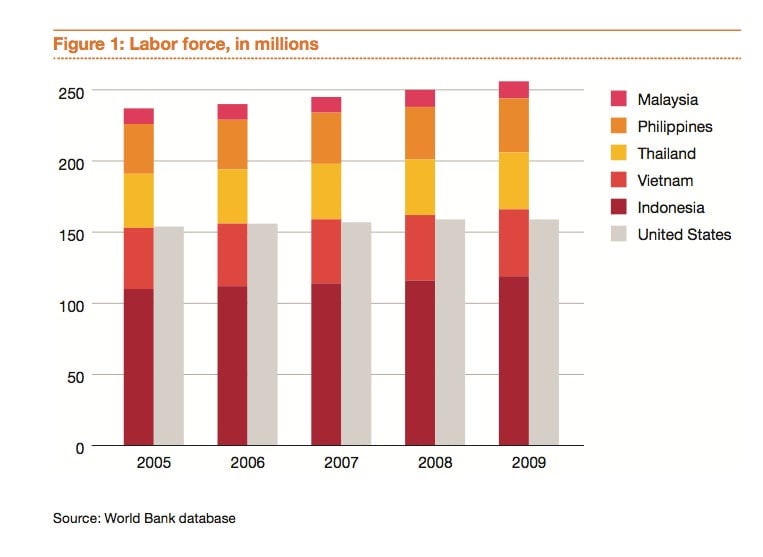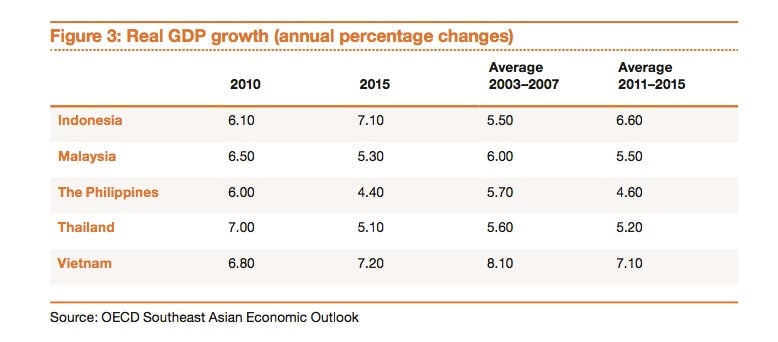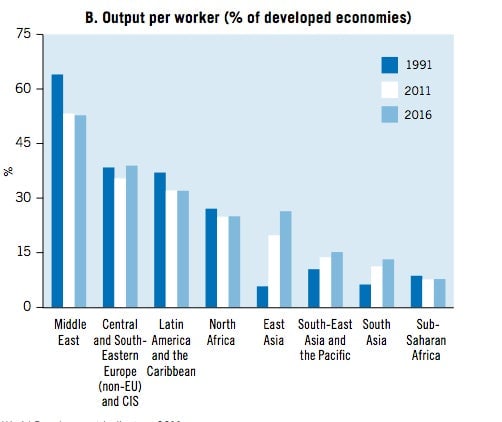Why the forecast South East Asia investment boom may just be a bankers’ sales job
Western bankers and consultants once viewed South East Asia mostly as a cheap holiday destination. Now they are widely promoting Indonesia, Thailand, Malaysia, the Philippines and Vietnam as hot investments. McKinsey issued a massive report back in September touting the attractiveness of Indonesia. It also likes Vietnam. A senior partner at a big four accounting firm based in Hong Kong told Quartz in recent days: “I am spending an awful lot of time in Malaysia looking for deals our clients might want to do there.” Goldman Sachs has been urging its clients to buy more Indonesian shares. Goldman is also expanding its Malaysian business, as is Bank of America. And Morgan Stanley says it likes Thai equities.


Western bankers and consultants once viewed South East Asia mostly as a cheap holiday destination. Now they are widely promoting Indonesia, Thailand, Malaysia, the Philippines and Vietnam as hot investments. McKinsey issued a massive report back in September touting the attractiveness of Indonesia. It also likes Vietnam. A senior partner at a big four accounting firm based in Hong Kong told Quartz in recent days: “I am spending an awful lot of time in Malaysia looking for deals our clients might want to do there.” Goldman Sachs has been urging its clients to buy more Indonesian shares. Goldman is also expanding its Malaysian business, as is Bank of America. And Morgan Stanley says it likes Thai equities.
Companies and fund managers are listening to their advisors. KKR, the giant US private equity fund, has said it sees big opportunities for 2013 in Malaysia, Thailand, Indonesia, the Philippines and Vietnam. But it is not just the bules (Indonesian for foreigner, pronounced boo-lay) or farangs (Thai for foreigner) who want to spend money here. South East Asian tycoons are also doing deals that suggest assets in this region are undervalued. The showdown between Indonesia’s wealthy Riady family and Thai tycoon Charoen Sirivadhanabhakdi over Fraser & Neave, a Singaporean conglomerate with assets around South East Asia, could be the start of an M&A boom here.
But it is uncertain how long these palm-fringed countries will stay in vogue. South East Asian policy makers are likely to fail to capitalize on the current investment boom by moving their economies up the value chain. Most have a long history of focusing on short term GDP growth ahead of investing sustainably in people and technology.
The big story is low-cost labor. As this report by accountants PwC outlines (pdf, pages 7-8) South East Asian countries have cheap, and fairly well educated, workforces. Foreign direct investment into the region rose 24% in 2011, PwC said. Part of this was because manufacturers are leaving China or these somewhat cheaper countries. More job opportunities are creating higher wages.

And long-term forecast growth rates for South East Asian countries look healthy.

But these projections could be rosy. Growth stories based on cheap labor are not guaranteed to last. Economist Paul Krugman, in a 1994 paper (pdf), argued countries that create economic growth with “perspiration, not inspiration” cannot sustain high growth rates. “Mere increases in inputs, without an increase in the efficiency with which those inputs are used–investing in more machinery and infrastructure–must run into diminishing returns; input-driven growth is inevitably limited,” he wrote. Meanwhile in the US, Krugman added, ”technological progress has accounted for 80% of the long-term rise,” in per capita income.
To grow sustainably, countries need to raise labor productivity and invest in technology. Here, South East Asian countries are challenged. Labor productivity is woefully low across the region. Visitors to shops and restaurants in Jakarta, Manila, Hanoi, Bangkok or Kuala Lumpur will notice that, in shops and restaurants, bored and tired looking staff are often standing around doing nothing. At the same time, customers are standing in long queues not being served, or simply walking out in frustration. Employers do not seem to know how to organize their labor force to make them most productive and governments do not invest heavily in helping them learn. As this report by the United Nations states (pdf p.40), adjusted for differences in prices across countries, the average output per worker in South East Asia is around 15% of that in developed countries. That is even though South East Asians often work extremely long hours. The UN also does not see productivity rising very fast between now and 2016.

A lack of emphasis on upgrading technology is also a problem. From Indonesia’s coffee farms to Vietnam’s cement factories, inefficient and aging technology is a major issue. As the OECD said in this report (pdf, p.32) last year, “the use of labor-intensive methods or previous generation of process technology can provide an explanation for the current low levels of labour productivity in many Southeast Asian countries.”
South East Asian policy makers tend to focus too much on overall GDP growth at the expense of longer term improvements in innovation and productivity. In Malaysia, the challenge of speeding up slow labor productivity growth is always a focus of debate. Thailand has similar issues. In this column, veteran Asia commentator Philip Bowring highlights how Thailand’s government favors populist, short term income and boosting policies, such as subsidies for farmers, over more sustainable endeavors. He writes: ”Policy makers need to encourage rural incomes to rise naturally through productivity gains. Efforts should be made to raise farm productivity through mechanization, land consolidation and new technology.” Meanwhile the World Bank said in this 2010 report (pdf p.9) that Indonesia’s reluctance to allow skilled immigrants into the country was limiting “this potentially important source of informal skills transfers and acquisition.”
So while these countries are experiencing an investment boom, it might end soon. Foreign manufacturers have switched away from China and toward nations such as Indonesia because of lower wages. But across South East Asia, workers are already demanding to be paid more. The Indonesian government is mulling a minimum wage boost of up to 50%. Thailand raised wages across the country by up to 40% earlier this year and is expected to hike minimum pay again next year. Vietnam is also discussing double-digit wage increases for next year. South East Asian governments need to find a way to improve their peoples’ lives over the long term before the world’s basic goods manufacturers move somewhere else.